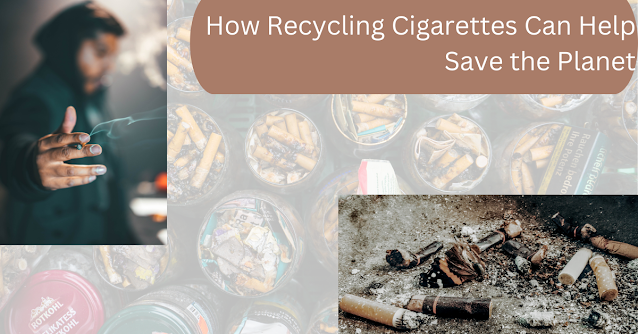 |
| How Recycling cigarettes can help Save the Planet |
- As billions of trillions of cigarettes and bidis are smoked each year around the world, the waste from tobacco products, particularly cigarettes and bidis, poses a serious threat to the environment. One of the most frequent finds on beaches is this.
- An estimated 340 to 680 million kilograms of waste tobacco are dispersed throughout the world.
- Approximately 5989 tons of cigarette waste was created in India in the years 2021–2022, and over 5300 tons were discarded into the environment.
How are cigarettes made?
- Cigarettes are made from cellulose acetate, a slow and non-biodegradable synthetic polymer.
- Cellulose acetate is produced by esterifying wood pulp or bleaching cotton pulp with acetic acid.
- The filter of a cigarette with a filter tip is made of cellulose acetate fibers. This is harmful to the environment.
How can cigarette waste damage the environment?
- Waste from tobacco products contains more than 7000 hazardous compounds, including at least 50 known human carcinogens and many of them are harmful to the environment.
- The cigarette filters may shatter into smaller plastic pieces under certain conditions (such as sunshine and moisture), eventually releasing some of the 7,000 compounds found in a cigarette.
- Research has shown that toxic substances including nicotine, arsenic, polycyclic aromatic hydrocarbons (PAHs), and heavy metals can seep from used tobacco product waste and be extremely detrimental to aquatic life, including fish.
How are cigarette butts recycled?
1. The cigarette butts can be chemically processed to remove impurities and later can be recycled into a variety of industrial products, such as plastic pallets. (Processing Steps involved: Cleaning, melting, pelletizing through extrusion).
- The cellulose acetate pellets can be combined with other plastics such as polyethylene or polypropylene for making of new plastic products.
- Materials made from used cigarette butts would have a potential use for noise barriers.
- Absorption efficiency depends upon the length and density of cigarette butts used.
3. Cigarette butts can be used for the production of clay-fired bricks. Significant amounts of firing energy can be saved for bricks with cigarette butt's content.
- The density of the brick becomes lighter with an increase in the CB content. Lower density bricks are beneficial in construction due to their ability to reduce the dead load in the structure.
- They are lighter and easier to handle, which reduces transport costs.
- They have a lower thermal conductivity that determines the heat loss of a building.
4. Cellulose acetate in discarded cigarette filters can be converted into a high performing material that could be integrated into computers, handheld devices, electrical vehicles and wind turbines to store energy.
These materials have demonstrated superior performance as compared to commercially available carbon, graphene and carbon nanotubes.
5. Plant-based filters can be made of a blend of all-natural, food-grade fiber utilizing a starch-based binder, a sustainable alternative to synthesized cellulose acetate.
- The plant-based filter material will have bio-degradability characteristics and hence will degrade in compost within a number of days.
- This is as opposed to cellulose acetate, which has been shown to take 10-15 years to degrade.
- Polyactic fiber can be used instead of cellular acetate for manufacturing of the cigarette butts.
GREENBUTTS, made Plant primarily based
totally filters.
Benefits of recycling cigarette butts
- Recycling cigarette butts helps to reduce the amount of waste in landfills.
- Recycled cigarette butts can be used to create new materials, such as plastic and concrete.
- Recycling cigarette butts helps to reduce the amount of toxins entering the environment.
Suggestion:
- To reduce non-degradable waste, use cigarette boxes made of recycled plastic or biodegradable materials.
VISIT
THIS WEBSITE FOR COMPLETE DETAILS:
Learn about atomic absorption spectroscopy in 5 minutes
Advantages and disadvantages of atomic absorption spectroscopy
Protecting the Planet: Key Environmental Issues and What you
Can Do
Atomic
Absorption Spectroscopy: Applications in Environmental Analysis
The
Rarest Places Where Micro-plastics are Found: Pollution Research
Environmental
Engineering Careers: Opportunities for Students in Sustainable and Green
Engineering





0 Comentaris